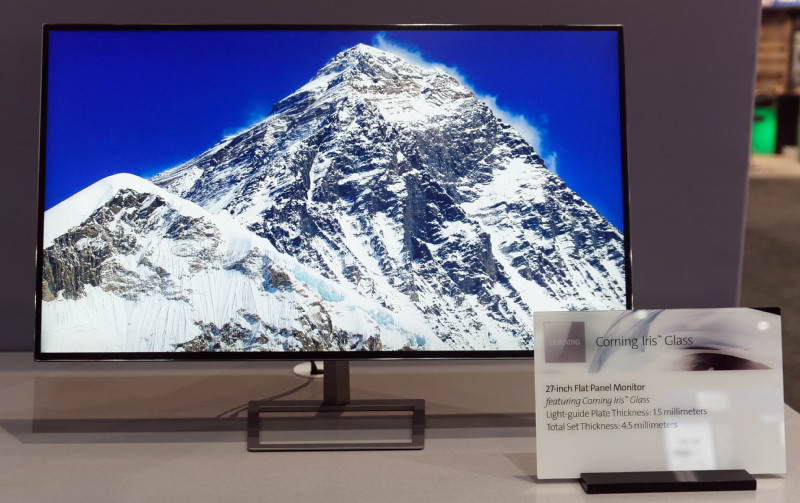Corning held its customary press breakfast and booth tour at the show. We started by looking at the development that Corning has done with Pegatron (as the OEM) and AUO (as the panel supplier) to put a couple of curved flexible LCDs into a configuration that also included a flat centre console display. The displays are put behind a cold formed glass surface. This is important and difficult, Corning said. Normally, curved glass is hot formed, but this has challenges because the surface of the glass is ‘destroyed’ which degrades visual performance. The firm also said that there was around a 50% cost saving, compared to hot forming. Surfaces that can be applied to the glass include anti-reflective and anti-glare coatings as well as anti-fingerprint. The glass is basically ‘pushed to shape’ and the panels are bonded onto the glass.
The glass used is 0.4mm thick and is Gorilla Glass. The 12″ flexible LCDs had a radius of 1000mm. Corning highlighted that this was just a ‘technology demo’, but it looked close to feasible for mass production to us.
 Corning developed this automotive concept with Pegatron, using flexible LCDs from AUO. Image:Meko
Corning developed this automotive concept with Pegatron, using flexible LCDs from AUO. Image:Meko
Corning also talked about its Lotus NXT glass, which was designed for use in LTPS and oxide TFT displays, but has also found a market opportunity in being a suitable carrier glass for the plastic films used as substrates for flexible OLEDs, partly because its very low ‘total pitch variation’. Mike Kunigonis said that the glass has an advantage in transmitting 30% more UV light than competitive glass.
Corning spoke about its Iris LGP glass that is finding a market in slim TVs, especially in China, at the business conference (BC09 Corning Adds More on LGPs). On the showfloor, the company also showed concept designs that it has made with monitor makers and on display was a 27″ concept monitor that was just 4.5mm thick, using an Iris LGP of 1.5mm thickness. Corning told us that it had been surprised by the positive response to the concept. The Iris glass has better coupling to the LEDs and also has much better thermal stability, so as monitors get bigger, it may become more popular. The company told us that it could go down to 1.1mm thickness or even thinner, but the issue of coupling is really a practical limit. Designs could get down to around 3.7mm. Products are expected in the market ‘soon’.


